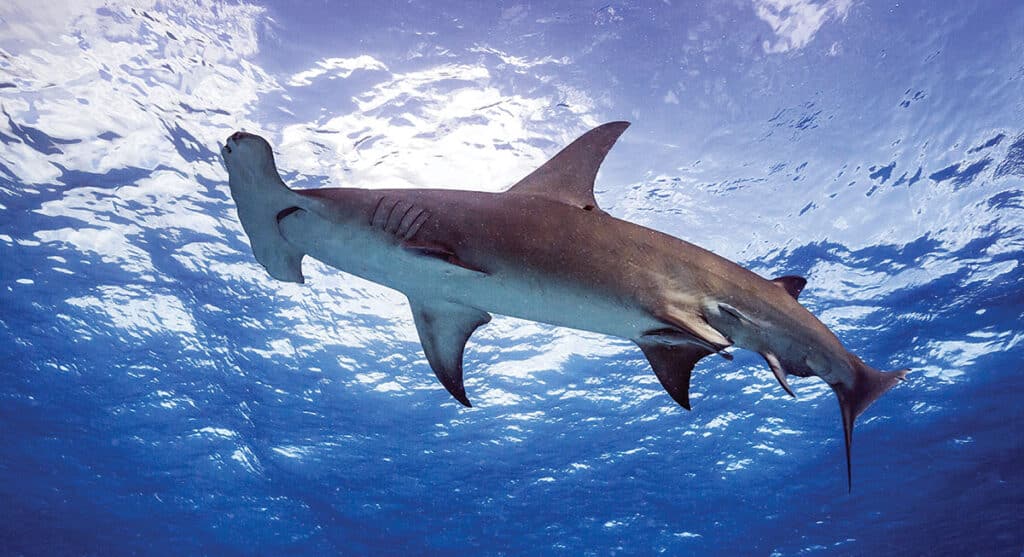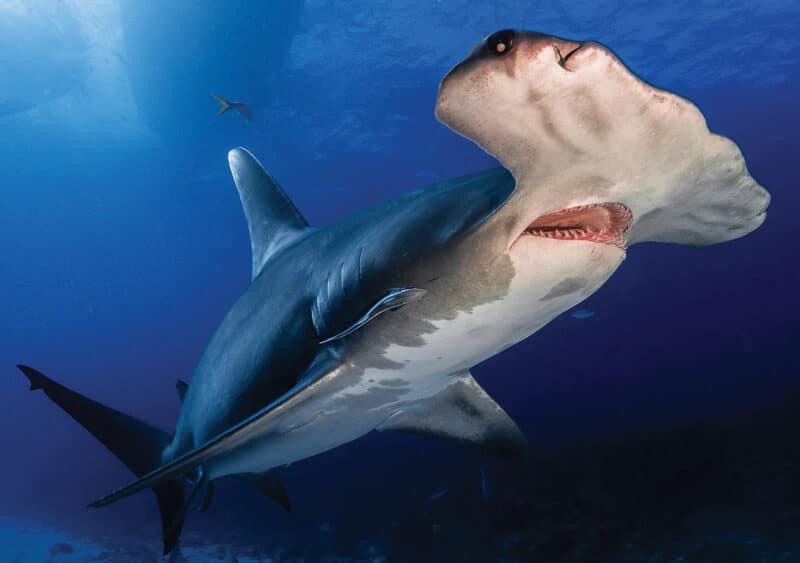by Dr. Sarah Treanor Bois, PhD
Director of Research & Education at the Linda Loring Nature Foundation
As part of a recent work trip to Maryland, I found myself at the National Aquarium in Baltimore. It was a great facility with an amazing central tank with creatures large and small from the Atlantic. It’s fun to go from tank to tank and check out all the creatures. But it’s that central tank full of the BIG fish that draws the crowds.
With the crowd blocking the glass, I wasn’t sure what was in there at first: an octopus? A giant sea turtle? Then I heard it. The anthem sung by a million toddlers torturing parents and care-givers alike. “Baby shark, do, do, do, do, do…” You know the rest.
It was funny to go all the way to Maryland to see the sharks up-close. Hammerheads, sandbar sharks, sand tiger sharks, and rough tailed rays–all species cruising through the aquarium–could be found right here on Nantucket! I could have stayed home and just jumped in the water.

Sharks are all anyone seems to be talking about lately. How many beach closings have there been in the past few weeks due to shark sightings? More than 45 confirmed fins just last week. It seems like every other day there are multiple closings along the south shore.
So why are there more and different shark species around Nantucket? What are they doing and are they a danger to us? Let’s dig in and find out more.
Many people know that the movie Jaws was filmed on our neighboring island, Martha’s Vineyard (though inspired by a true shark story from New Jersey in 1916). That movie was successful in launching a “scary nature creature” industry, but it also succeeded in striking fear of the ocean and fear of sharks in particular. Shark populations in general, but certainly Great Whites, declined significantly afterwards due to overfishing and decline in prey numbers. More recent conservation efforts and protections have helped many shark species rebound.
Of course, there have always been sharks in the ocean. The recent sightings are the results of a combination of things. First, there are more eyeballs on the water. The heatwave of summer plus post-pandemic travel has meant more people on our Nantucket beaches than ever before. Drones, more beaches with lifeguards, and more beach-goers mean more people looking, watching for, and reporting shark activity.
Another primary factor is shark conservation. Many scientists believe that there are more sharks around Nantucket during the last five years partly because the populations are in recovery after an 80% decimation from being overfished in past decades.
While shark populations are still considered critical globally, marine biologists are beginning to see the benefits of effective fisheries management, which is then leading to population increases across a number of species that provide food for sharks.
As for those species that are newer to our waters? The waters around New England are warming making them more hospitable to some species. NASA’s Earth Observatory reports that the Gulf of Maine, which stretches from Cape Cod to Canada, is warming faster than 96 percent of the world’s oceans. These waters, which include those around Nantucket, are also staying warmer longer. This heat wave we’re experiencing now will delay cooling in the fall.
Since 2008, fall sea surface temperatures have warmed around 1.1 degree each decade. Four of the warmest fall seasons have occurred in the past seven years. This means warm water species we’ve been thinking of as anomalies, may become regular visitors. If the trend continues, they may become seasonal residents.
The temperature changes have not gone unnoticed by anglers and beach goers. On Nantucket, we’ve received reports of unusual animals in the area—including creatures like the smooth hammerhead shark. Other familiar marine species, such as herring and striped bass, are also sticking around longer instead of migrating.
You’ve probably seen the many photos and videos going around of hammerhead sharks close to shore and even in the surf of popular beaches. I wrote about a few sightings in 2020, but this year’s sightings (plus photos and videos!) have far out-matched previous seasons.
Hammerhead sharks, of which there are many species, are more typically found in warmer, tropical-like waters. With the gulf stream extending further north, hammerheads are being seen more frequently along the coast where previously it would have been too cold. Unlike great white sharks, hammerheads and other warm water species like bull and tiger sharks cannot regulate their body temperatures by generating heat. Cold water shuts them down. The warming water is extending their range. They also go where the food is. Hammerheads feed on fish, invertebrates and small sharks and rays. They generally avoid interreacting with humans and are not considered aggressive.
Another important thing to remember is that predators follow the food. It isn’t just all about temperature, though that is important. Great White sharks, for example, like our cooler water and are here now following the food. Many conservation efforts for marine mammals (including seals) and changes in the fishery for other species, like the Atlantic menhaden, mean more fish and prey species. Baitfish are moving in followed by bigger fish (stripers, porgies, menhaden, etc.), and the bigger predators follow them. More sharks in the surf are a good sign to anglers that the fish are around. It may be tricky to land a fish when there’s a shark or a seal also fishing for a meal, but the fish are there.
Anglers have been noticing changes to ocean life for some time. It might not just be new species, but also changes to the timing of arrivals such as bonito and false albacore, striped bass, and bluefish—their activity is primarily temperature dependent. As the waters warm earlier in the season and stays warmer later into the fall, the fishing changes as well. We’ve already had some bonito caught as well as some super early albies.
As one Florida marine biologist noted: “To see lots of sharks means you have a robust ecosystem that can support them.” And that is a good thing.
Remember: you have just a 1 in 4,332,817 chance of dying from a shark bite. You’re more likely to die from a lightning strike, fireworks, or a space accident.



